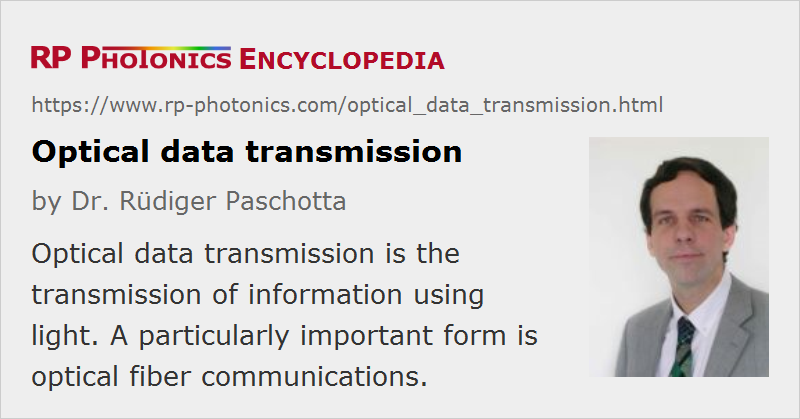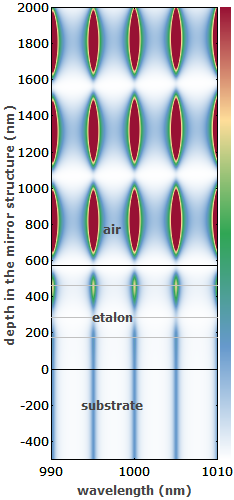Optical Data Transmission
Definition: the transmission of information using light beams, e.g. in fibers
More specific terms: free-space optical communications, optical fiber communications
German: optische Datenübertragung
Category: lightwave communications
How to cite the article; suggest additional literature
Author: Dr. Rüdiger Paschotta
Light has an enormous potential for data transmission with very high data rates. This is basically a consequence of the high optical frequencies, which also make it possible to utilize very broad optical bandwidths. For example, the wavelength range from 1.3 to 1.6 μm, which may be transmitted in an optical fiber, corresponds to a bandwidth as large as 43 THz, which is orders of magnitude higher than that of any electrical cable. Even though the theoretical potential of this bandwidth can so far not be fully utilized, an optical link (either a free-space link or a fiber-optic link) can have a capacity far beyond that of an electrical cable, or of a radio frequency link. There have already been demonstrations of fiber-optical data transmission systems with more than 1 Tbit/s.
For a limited optical bandwidth, the maximum bit rate for data transmission depends on the signal-to-noise ratio of the transmission system. According to the Shannon–Hartley theorem, the possible virtually error-free bit rate scales with the logarithm of 1 plus the signal-to-noise ratio. Particularly for high signal-to-noise ratios, fiber-optical transmission systems (see below) can not fully realize that theoretical potential, since nonlinearities lead to signal distortions. In practice, the achievable spectral efficiency is roughly 1 bit/s per Hertz of optical bandwidth, and depends on the modulation format. Advanced modulation formats, such as differential quadrature phase shift keying (DQPSK), promise somewhat higher values of spectral efficiency.
Laser-based communications is clearly the most important laser application in terms of global laser sales, and in addition still exhibits strong growth.
Guided versus Free-space Transmission
In most cases, optical data transmission uses optical fibers as the transmission medium (→ optical fiber communications), because light can be guided in fibers over very long distances with very low losses, also avoiding alignment issues, atmospheric influences, and the like. However, there are also applications for free-space optical communications, e.g. between Earth-orbiting satellites, between a remote spacecraft and an Earth-based station, or over short distances between metropolitan buildings.
Bit Error Issues
Even a digital transmission system is not totally error-free – statistical fluctuations related to noise influences (e.g. laser noise, amplifier noise, shot noise, or excess noise of a receiver) cause a small fraction of the transmitted bits to be defective. Typically, the bit error rate (i.e., the fraction of incorrectly transmitted bits) is strongly dependent on the transmitted power, and the latter must be high enough to keep the bit error rate below a certain acceptable level (e.g. 10−12 for Earth-based telecommunication systems, or 10−6 for satellite control). Practically all of the remaining bit errors can be detected (e.g. using some kind of checksums) and corrected. The error correction scheme can use some level of redundancy in the transmitted data or involve retransmitting corrupted data packets. Additional detrimental influences such as fiber losses or various types of dispersion in a longer link, or background light in free-space transmission, can often be compensated by somewhat increasing the transmitted power. The increase of optical power required to maintain a given bit error rate is called a power penalty, or more specifically e.g. a dispersion penalty if dispersion is the considered factor.
From Larger to Smaller Distances
Optical data transmission is increasingly used in various areas, such as telephony, Internet traffic, cable TV – mostly for larger transmission distances of at least a few kilometers. There is, however, a tendency for optical systems to penetrate areas with smaller and smaller transmission distances. Particularly in Japan, many Internet connections are already delivered to homes with optical fibers (→ fiber to the home). Current local area networks (LANs) work well with electrical cables for data rates of 100 Mbit/s, but at rates of e.g. 10 Gbit/s, optical connections will become important, because electrical cables are expensive and lossy at microwave frequencies. Supercomputers may soon extensively use optical interconnects for short distances.
Optical board-to-board connections, optical chip-to-chip and even intra-chip connections are being seriously considered, and are partly already developed. For example, an increasing portion of the area of current CPU chips is occupied by electrical data transmission lines. At high data rates, it is expected to be favorable in terms of space and also of energy consumption to realize such transmission lines with optical means. A challenge, however, is still to develop suitable micro- or nano-lasers, which can be operated with very low power levels, and can be fabricated on silicon wafers.
Another possible application (yet at the R & D stage) is short-distance data transmission within rooms, e.g. from an LED-based transmitter at the ceiling to a PC, a notebook or a smaller mobile device. The transmitter does not send out a directed beam, but illuminates a large area. Due to the relatively small distances, one can still achieve a reasonably high signal-to-noise ratio for realizing high data rates. This approach is competing with traditional wireless communications e.g. based on Wi-Fi (WLAN). Possible advantages of optical transmission include higher data rates and avoiding interference or interception problems, as the sent-out light will usually not be detectable in other rooms. A problem, however, is the back channel, particularly for small mobile device which cannot use a powerful light emitter for reasons of power consumption. One possibility is to use radio transmission for the back channel. For many applications such as video streaming this can work well, since download data rates are far higher than upload rates.
Suppliers
The RP Photonics Buyer's Guide contains 84 suppliers for optical data transmission systems.
Questions and Comments from Users
Here you can submit questions and comments. As far as they get accepted by the author, they will appear above this paragraph together with the author’s answer. The author will decide on acceptance based on certain criteria. Essentially, the issue must be of sufficiently broad interest.
Please do not enter personal data here; we would otherwise delete it soon. (See also our privacy declaration.) If you wish to receive personal feedback or consultancy from the author, please contact him e.g. via e-mail.
By submitting the information, you give your consent to the potential publication of your inputs on our website according to our rules. (If you later retract your consent, we will delete those inputs.) As your inputs are first reviewed by the author, they may be published with some delay.
Bibliography
| [1] | R.-J. Essiambre et al., “Capacity limits of optical fiber networks”, J. Lightwave Technol. 28 (4), 662 (2010), doi:10.1109/JLT.2009.2039464 |
| [2] | R. S. Tucker, “Green optical communications – part I: energy limitations in transport”, IEEE J. Sel. Top. Quantum Electron. 17 (2), 245 (2011), doi:10.1109/JSTQE.2010.2051216 |
| [3] | R. S. Tucker, “Green optical communications – part II: energy limitations in networks”, IEEE J. Sel. Top. Quantum Electron. 17 (2), 261 (2011), doi:10.1109/JSTQE.2010.2051217 |
| [4] | Harry J. R. Dutton, Understanding optical communications, http://www.freeinfosociety.com/media/pdf/5475.pdf, IBM Redbooks |
| [5] | G. P. Agrawal, Fiber-Optic Communication Systems, John Wiley & Sons, New York (2002) |
See also: optical fiber communications, fiber-optic links, fiber to the home, radio and microwave over fiber, quantum cryptography, amplifier noise, free-space optical communications
and other articles in the category lightwave communications
 |





If you like this page, please share the link with your friends and colleagues, e.g. via social media:
These sharing buttons are implemented in a privacy-friendly way!